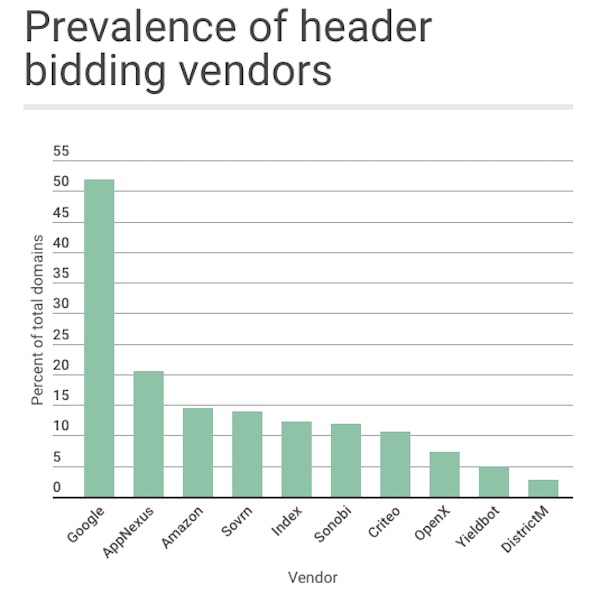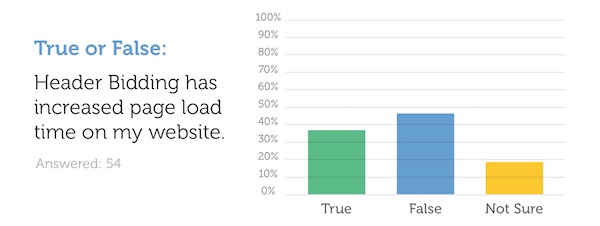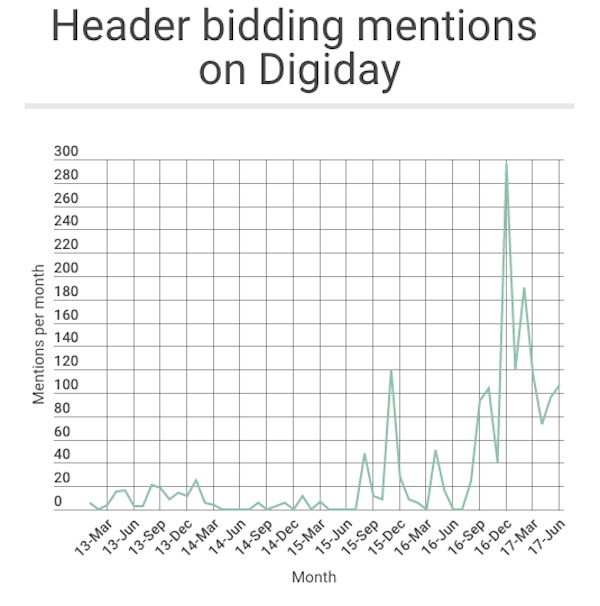Save 50% on a 3-month Digiday+ membership. Ends Dec 12.
Header bidding has had an uptick in popularity in the past two years, and is now used by the majority of the internet’s most popular sites.
Header bidding allows publishers to simultaneously offer inventory to multiple exchanges before making calls to their ad servers — giving most of its adopters a 20-30 percent bump in CPMs, according to separate studies by Prohaska Consulting and Sonobi. But it’s also contributed to slow page-load times and strained the infrastructure of programmatic platforms.
Here are four charts that summarize the state of header bidding.
Industry adoption
In July, Sizmek examined the code of the 30,000 most popular websites on the internet and found that 60 percent of the domains included tags from header-bidding vendors. Sizmek didn’t track vendor tags that are hosted in server-to-server connections, it still provides a good idea of the prevalence of header bidding since few publishers have gone all-in on server-side bidding.

The most popular bidder remains Google, which appeared on more than half of the domains Sizmek analyzed. But given that Google had a near monopoly back when the publisher waterfall was the dominant method for selling inventory programmatically, it’s clear header bidding has opened the door for other vendors to sell large swaths of inventory.
Slow load times
The biggest problem with header bidding is that it often slows sites by adding code to the publisher’s site. About 40 percent of publishers who adopted header bidding noticed it slowed down their sites, according to a survey by ad tech firm Sovrn.
Most publishers’ tech setups aren’t sophisticated enough to identify the ad units or vendors that cause the most latency. For publishers that have lots of third parties plugged into their tech stacks, the sluggishness that header bidding causes can be a wake-up call to re-examine their ad setup, said Emry Downinghall, vp of advertising at online book rental company Chegg.

Entrenched buzzword
People didn’t always use to the phrase “header bidding” to refer to unified auctions. For years, vendors pushed their own nomenclature. As the chart below shows, the phrase took off in the summer of 2015. The term’s growth is credited to a private programmatic Slack channel, AdMonsters events and AdExchanger articles using the buzzword.
Digiday has also jumped on this bandwagon. Shift Communications ran a crawler on our site and found that our use of header bidding has skyrocketed over the past year.

Platform strain
Header bidding lets publishers make their inventory available to as many exchanges as they want at the same time. This has contributed to an explosion in bid requests that programmatic platforms have to process.
There are no industrywide figures on the uptick in bid requests, but the trend is seen across large platforms. Turn processed around 1.3 million ad impressions per second in 2014, but by December, it was processing 4.5 million impressions per second. The Trade Desk processed about 1 million impressions per second two years ago; by December, it was processing 5.7 million impressions per second. Rubicon Project processes about 20 billion ad impressions per day, about five times what it processed two years ago.
Since processing bid requests strains DSP servers, these platforms are looking to algorithms to determine which impressions they’re unlikely to win and should avoid bidding on to reduce their infrastructure costs. This problem isn’t going away anytime soon.
“The [infrastructure] issues are going to be the biggest problem facing the industry, and until the major DSPs take significant steps to figure it out without relying on buzzwords like ‘machine learning’ and ‘artificial intelligence,’ then someone will be losing money,” said Adam Hecht, vp of monetization at ad tech firm SintecMedia.
More in Media

Digiday+ Research: Publishers’ growing focus on video doesn’t translate to social platforms
Major publishers have made recent investments in vertical video, but that shift is not carrying over to social media platforms.

Technology x humanity: A conversation with Dayforce’s Amy Capellanti-Wolf
Capellanti-Wolf shared insight on everything from navigating AI adoption and combating burnout to rethinking talent strategies.

How The Arena Group is rewriting its commercial playbook for the zero-click era
The company is testing AI-powered content recommendation models to keep readers moving through its network of sites and, in doing so, bump up revenue per session – its core performance metric.








